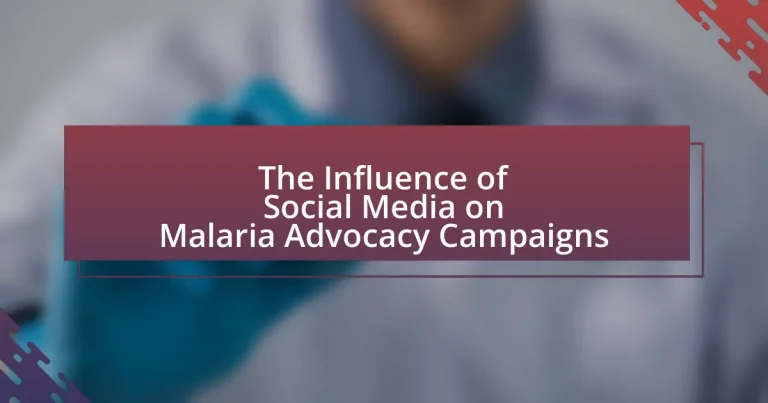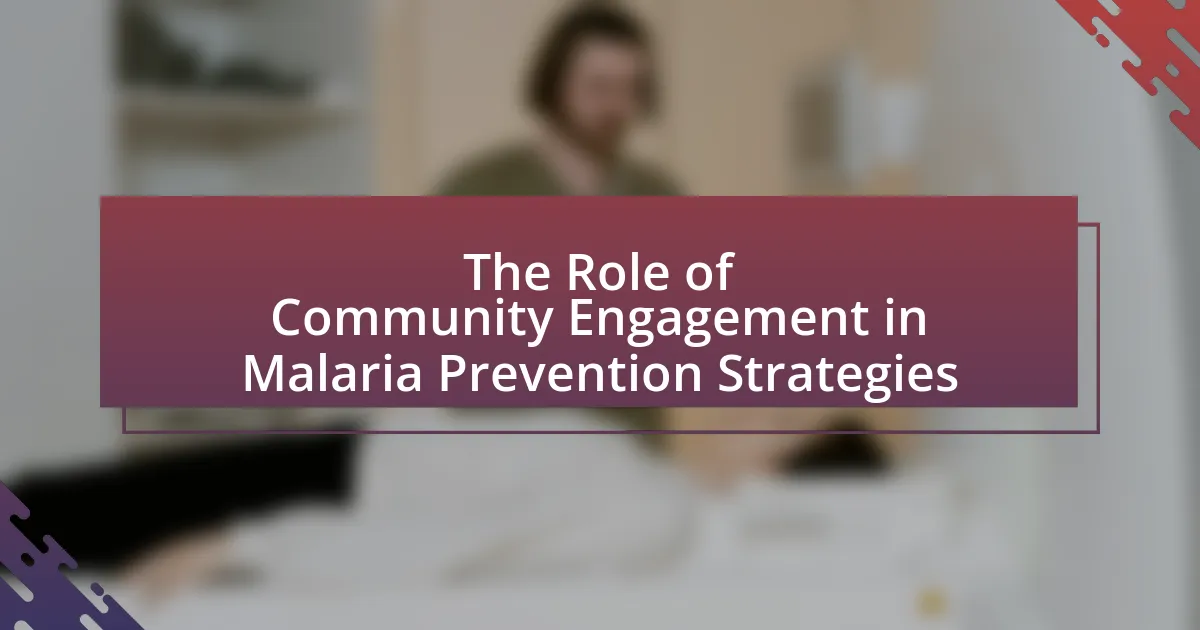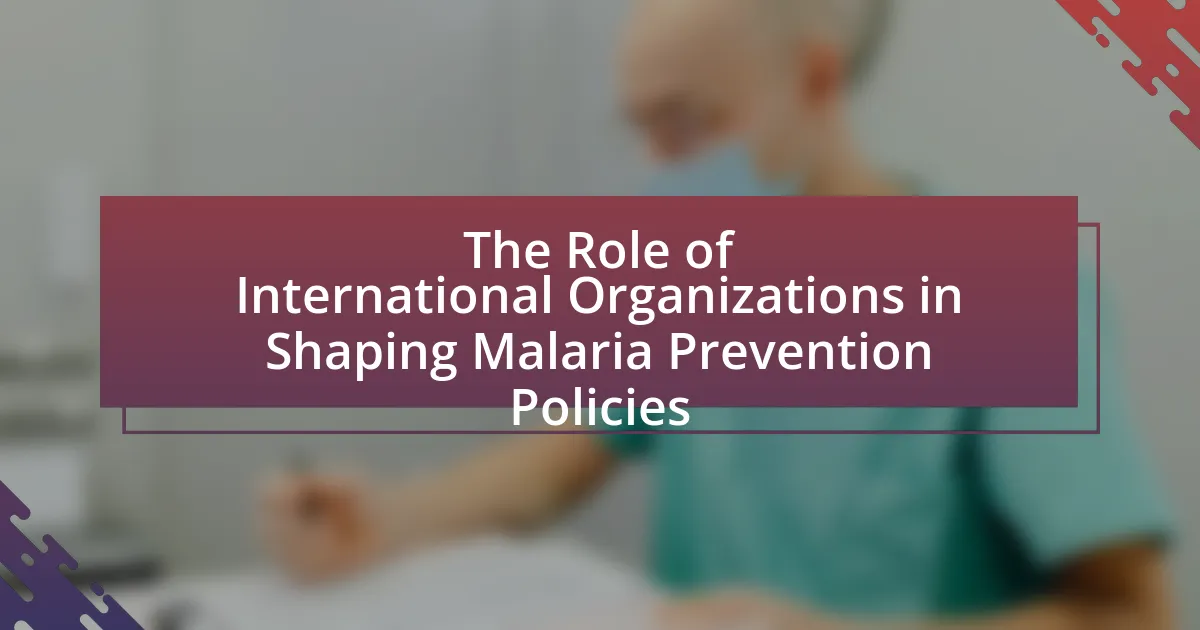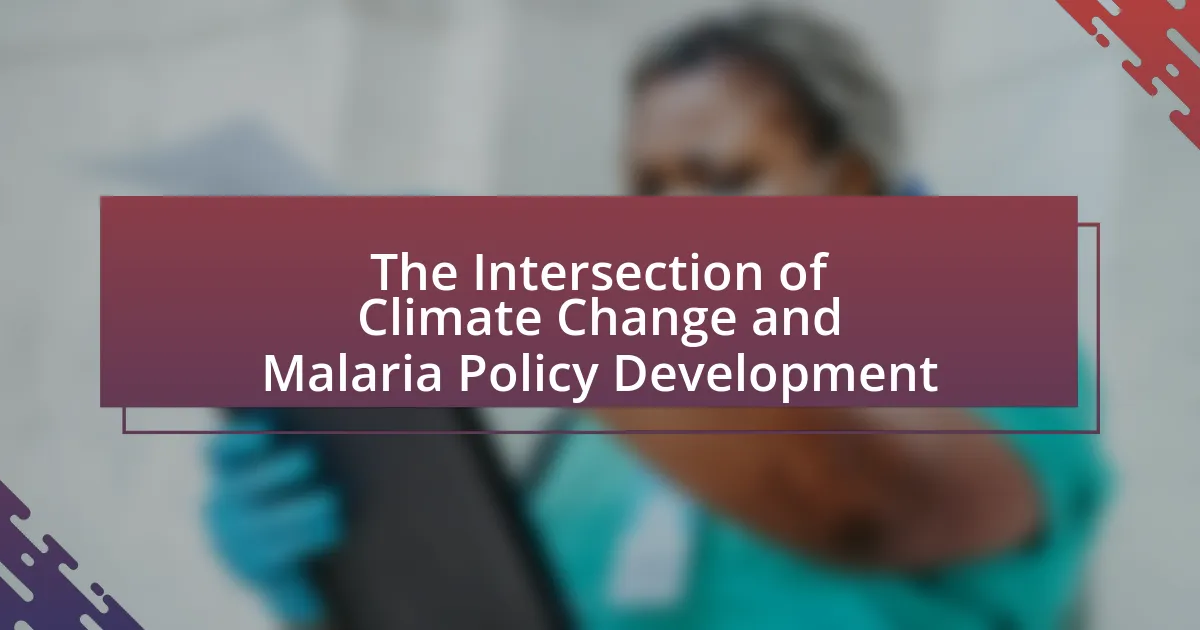The article examines the significant influence of social media on malaria advocacy campaigns, highlighting how platforms like Facebook and Twitter enhance awareness, mobilize support, and facilitate information dissemination. It discusses the transformation of malaria advocacy through real-time engagement, the effectiveness of various social media platforms, and the challenges posed by misinformation. Key strategies for successful campaigns, including the use of data analytics, storytelling, and audience feedback, are outlined, along with future trends in technology and collaboration that can further enhance advocacy efforts. The article emphasizes the importance of targeted messaging and engaging content in driving public awareness and action against malaria.
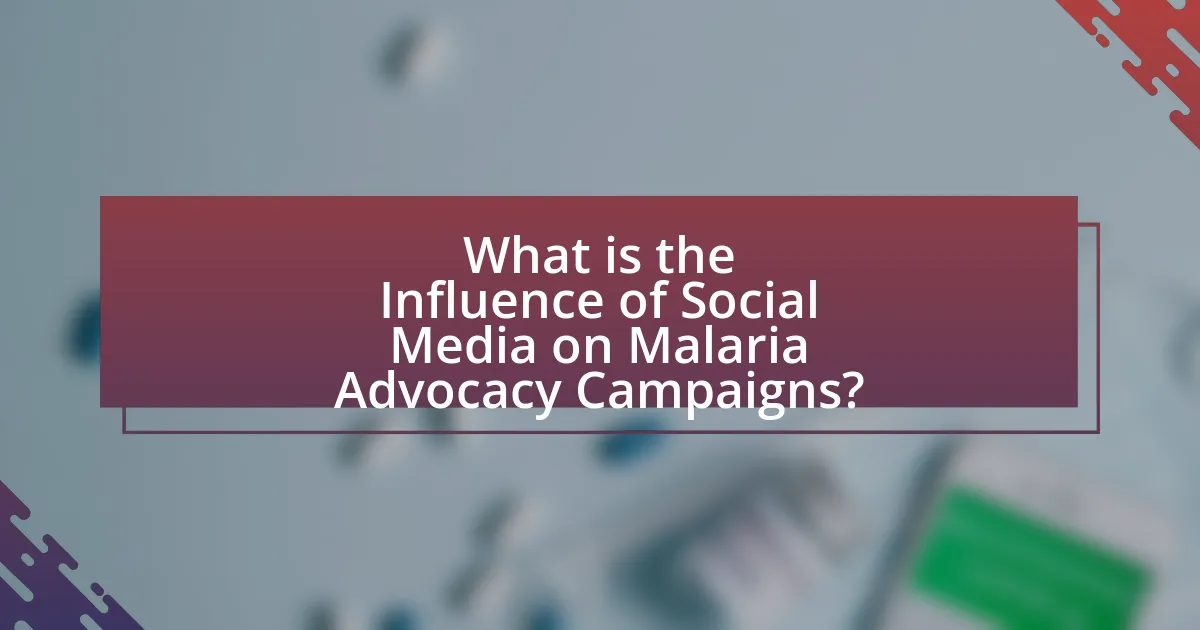
What is the Influence of Social Media on Malaria Advocacy Campaigns?
Social media significantly enhances malaria advocacy campaigns by increasing awareness, mobilizing support, and facilitating information dissemination. Platforms like Facebook and Twitter allow organizations to reach a global audience quickly, amplifying messages about prevention and treatment. For instance, the World Health Organization reported that social media campaigns can lead to a 30% increase in public engagement regarding health issues. Additionally, social media enables real-time interaction, allowing advocates to respond to inquiries and share success stories, which fosters community involvement and encourages donations. This interactive nature of social media has proven effective in rallying support for malaria initiatives, as evidenced by campaigns that have successfully raised funds and increased participation in malaria prevention programs.
How has social media changed the landscape of malaria advocacy?
Social media has transformed malaria advocacy by enhancing awareness, mobilizing support, and facilitating real-time information sharing. Platforms like Twitter and Facebook allow organizations to reach a global audience quickly, increasing visibility for malaria-related issues. For instance, the World Health Organization reported a significant rise in engagement during campaigns like World Malaria Day, where social media posts led to a 50% increase in public discussions about malaria prevention and treatment. This shift enables advocates to connect with diverse communities, share personal stories, and drive fundraising efforts more effectively than traditional methods.
What are the key platforms used in malaria advocacy campaigns?
Key platforms used in malaria advocacy campaigns include social media networks such as Facebook, Twitter, Instagram, and YouTube. These platforms facilitate widespread outreach and engagement, allowing organizations to share information, mobilize support, and raise awareness about malaria prevention and treatment. For instance, the World Health Organization and various NGOs utilize these platforms to disseminate educational content and updates on malaria initiatives, reaching millions of users globally. Additionally, social media analytics show that campaigns leveraging these platforms can significantly increase public engagement and donations, demonstrating their effectiveness in advocacy efforts.
How do these platforms facilitate communication and engagement?
Social media platforms facilitate communication and engagement by providing real-time interaction and broad reach to diverse audiences. These platforms enable users to share information, experiences, and resources related to malaria advocacy, fostering community involvement and awareness. For instance, campaigns can utilize hashtags to unify discussions, allowing users to easily find and participate in conversations about malaria prevention and treatment. Additionally, features like live streaming and interactive polls enhance engagement by encouraging direct feedback and participation from followers. Research indicates that social media campaigns can significantly increase public awareness and mobilize support, as seen in the “Malaria No More” campaign, which effectively used Twitter to engage millions and raise funds for malaria initiatives.
Why is social media important for malaria advocacy?
Social media is important for malaria advocacy because it enables rapid dissemination of information and mobilization of support. Platforms like Twitter and Facebook allow organizations to reach a global audience instantly, raising awareness about malaria prevention and treatment. For instance, the World Health Organization reported that social media campaigns can significantly increase public engagement and knowledge, leading to higher rates of preventive measures, such as the use of insecticide-treated nets. Additionally, social media facilitates community building and collaboration among stakeholders, enhancing the effectiveness of advocacy efforts.
What role does social media play in raising awareness about malaria?
Social media plays a crucial role in raising awareness about malaria by facilitating the rapid dissemination of information and engaging diverse audiences. Platforms like Facebook, Twitter, and Instagram enable health organizations and advocates to share educational content, updates on malaria prevention, and personal stories, which can significantly increase public knowledge and concern about the disease. For instance, campaigns such as the World Health Organization’s “World Malaria Day” utilize social media to reach millions, promoting preventive measures and encouraging community involvement. Research indicates that social media campaigns can lead to increased awareness and behavioral changes, as evidenced by a study published in the journal “Global Health Action,” which found that social media outreach effectively improved knowledge about malaria prevention in targeted populations.
How does social media influence public perception of malaria?
Social media significantly influences public perception of malaria by shaping awareness, disseminating information, and mobilizing community engagement. Platforms like Facebook and Twitter allow health organizations to share real-time updates, educational content, and personal stories, which can enhance understanding of malaria’s impact and prevention strategies. For instance, campaigns that utilize hashtags related to malaria can increase visibility and encourage discussions, leading to greater public interest and concern. Research indicates that social media can amplify the reach of malaria advocacy efforts, as seen in the 2019 World Malaria Day campaign, which generated millions of impressions and increased engagement on malaria-related topics. This demonstrates that social media serves as a powerful tool in altering perceptions and fostering a proactive approach to malaria prevention and treatment.
What challenges do malaria advocacy campaigns face on social media?
Malaria advocacy campaigns face significant challenges on social media, including misinformation, audience engagement, and platform algorithms. Misinformation can spread rapidly, leading to public confusion about malaria prevention and treatment, as evidenced by studies showing that false health information can undermine public health efforts. Additionally, engaging audiences effectively is difficult due to the oversaturation of content on social media platforms, which can dilute the impact of malaria messages. Furthermore, social media algorithms often prioritize sensational content over educational material, making it harder for advocacy campaigns to reach their target audiences. These challenges hinder the effectiveness of malaria advocacy efforts in raising awareness and promoting preventive measures.
How do misinformation and fake news impact malaria campaigns?
Misinformation and fake news significantly undermine malaria campaigns by spreading false narratives that can lead to public confusion and mistrust in health interventions. For instance, inaccurate information about malaria treatments or prevention methods can result in decreased adherence to recommended practices, such as the use of insecticide-treated nets or antimalarial medications. A study published in the journal “Health Communication” found that misinformation on social media can lead to a 30% reduction in the likelihood of individuals seeking proper medical care for malaria. This decline in trust and engagement can ultimately hinder efforts to control and eliminate malaria, as public health campaigns rely on accurate information to educate communities and promote effective health behaviors.
What are the limitations of using social media for advocacy?
The limitations of using social media for advocacy include the potential for misinformation, limited reach among target demographics, and the challenge of sustaining engagement. Misinformation can spread rapidly on social media platforms, undermining the credibility of advocacy efforts; for instance, a study by the Pew Research Center found that 64% of Americans believe that false information causes confusion about important issues. Additionally, social media may not effectively reach certain demographics, particularly older populations who may prefer traditional media; data indicates that only 37% of adults aged 65 and older use social media. Finally, sustaining engagement is difficult, as advocacy messages can quickly become lost in the vast amount of content shared daily, with research showing that engagement rates for advocacy posts often decline after initial interactions.

How do Social Media Strategies Enhance Malaria Advocacy Campaigns?
Social media strategies enhance malaria advocacy campaigns by increasing awareness, engagement, and mobilization of resources. These platforms allow organizations to reach a broader audience quickly; for instance, campaigns like #EndMalaria have successfully raised awareness and funds through viral posts and targeted ads. Research indicates that social media can amplify messages, with a study showing that campaigns utilizing platforms like Twitter and Facebook can increase public engagement by up to 50%. Furthermore, social media facilitates real-time communication, enabling advocates to share updates and mobilize support during critical moments, such as disease outbreaks. This immediacy and reach are crucial for effective advocacy in combating malaria.
What strategies are most effective for engaging audiences on social media?
Effective strategies for engaging audiences on social media include creating interactive content, utilizing storytelling, and leveraging user-generated content. Interactive content, such as polls and quizzes, encourages audience participation, leading to higher engagement rates. Storytelling humanizes the message, making it relatable and memorable; for instance, sharing personal experiences related to malaria can evoke empathy and drive action. User-generated content fosters community involvement, as audiences feel valued when their contributions are highlighted. According to a study by the Pew Research Center, 70% of social media users engage more with brands that encourage user interaction, demonstrating the effectiveness of these strategies in enhancing audience engagement.
How can storytelling be utilized in malaria advocacy campaigns?
Storytelling can be utilized in malaria advocacy campaigns by creating emotional connections that resonate with audiences, thereby increasing awareness and engagement. For instance, personal narratives from malaria survivors or healthcare workers can illustrate the disease’s impact, making the statistics more relatable and compelling. Research shows that campaigns incorporating storytelling can enhance message retention and motivate action; a study published in the Journal of Health Communication found that narratives significantly improved participants’ understanding of health issues. By leveraging storytelling, malaria advocacy campaigns can effectively mobilize support and drive behavioral change.
What types of content resonate most with social media users?
Visual content, particularly images and videos, resonates most with social media users. Research indicates that posts featuring visuals receive 94% more views than those without, highlighting the effectiveness of engaging imagery in capturing attention. Additionally, emotionally charged content, such as personal stories or testimonials related to health issues like malaria, tends to generate higher engagement rates, as users are more likely to share and comment on content that evokes strong feelings. This aligns with findings from the Pew Research Center, which shows that 68% of social media users prefer content that is visually appealing and emotionally impactful.
How can data analytics improve malaria advocacy efforts on social media?
Data analytics can enhance malaria advocacy efforts on social media by providing insights into audience engagement and content effectiveness. By analyzing metrics such as shares, likes, and comments, organizations can identify which messages resonate most with their target demographics. For instance, a study by the World Health Organization found that campaigns utilizing data-driven strategies increased engagement rates by up to 30%. This allows advocates to tailor their messaging and optimize their outreach strategies, ultimately leading to more effective awareness and fundraising initiatives.
What metrics should be tracked to measure campaign success?
To measure campaign success in malaria advocacy campaigns, key metrics include engagement rate, reach, conversion rate, and return on investment (ROI). Engagement rate quantifies interactions such as likes, shares, and comments, indicating audience involvement. Reach measures the total number of unique users who see the campaign content, reflecting its visibility. Conversion rate tracks the percentage of users who take a desired action, such as signing a petition or donating, demonstrating the campaign’s effectiveness in prompting action. ROI assesses the financial return relative to the campaign’s cost, providing insight into overall financial effectiveness. These metrics collectively offer a comprehensive view of a campaign’s performance and impact.
How can audience feedback shape future advocacy strategies?
Audience feedback can significantly shape future advocacy strategies by providing insights into public perceptions, preferences, and concerns regarding malaria. This feedback allows advocates to tailor their messaging and outreach efforts to better resonate with the audience, ensuring that campaigns are relevant and impactful. For instance, data from social media interactions can reveal which aspects of malaria advocacy are most engaging, guiding the development of targeted content that addresses specific audience interests. Research indicates that campaigns that adapt based on audience feedback can increase engagement rates by up to 50%, demonstrating the effectiveness of incorporating public input into advocacy strategies.
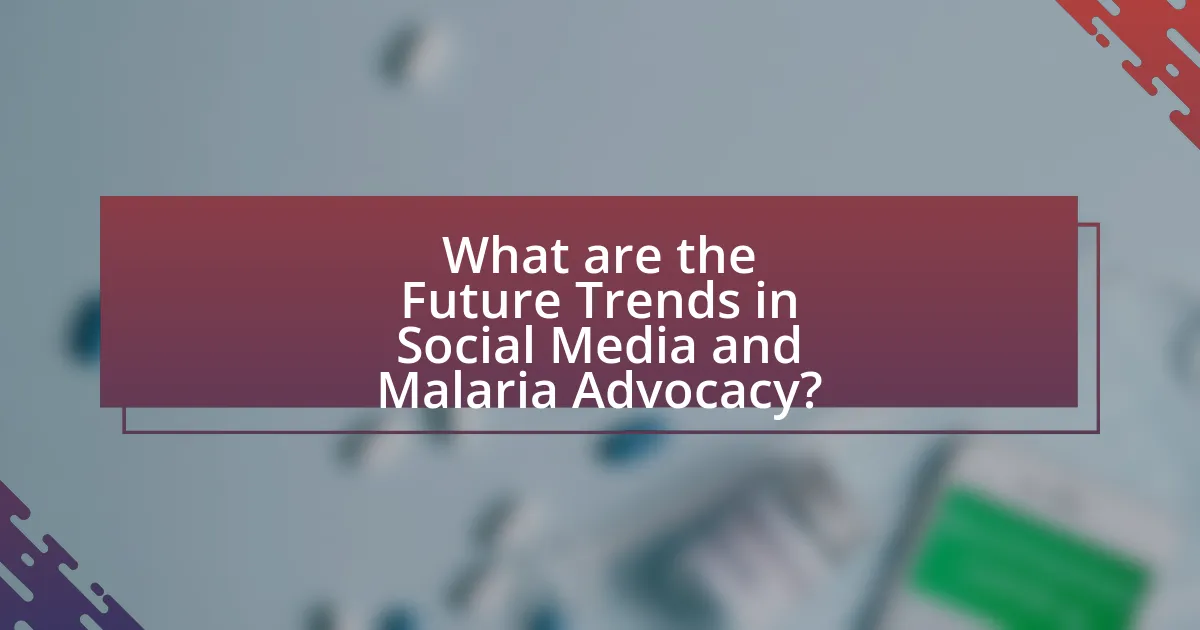
What are the Future Trends in Social Media and Malaria Advocacy?
Future trends in social media and malaria advocacy include increased use of data analytics, personalized messaging, and enhanced community engagement. Data analytics will allow organizations to track engagement metrics and optimize campaigns based on real-time feedback, leading to more effective outreach. Personalized messaging will cater to specific demographics, improving the relevance of content shared on platforms like Facebook and Twitter. Enhanced community engagement will leverage user-generated content and peer-to-peer sharing, fostering a sense of ownership and activism among individuals. These trends are supported by studies showing that targeted social media campaigns can significantly increase awareness and funding for malaria initiatives, as evidenced by the success of campaigns like the “Nothing But Nets” initiative, which utilized social media to distribute over 8 million bed nets in Africa.
How is technology evolving to support malaria advocacy on social media?
Technology is evolving to support malaria advocacy on social media through the development of targeted campaigns, data analytics, and mobile applications. These advancements enable organizations to reach specific demographics effectively, analyze engagement metrics, and disseminate information rapidly. For instance, platforms like Facebook and Twitter allow for real-time updates and community engagement, while data analytics tools help measure the impact of advocacy efforts. Additionally, mobile applications facilitate access to educational resources and enable users to report malaria cases, enhancing grassroots involvement. This evolution is evidenced by initiatives such as the World Health Organization’s use of social media to promote awareness and mobilize support, demonstrating the effectiveness of these technological advancements in combating malaria.
What role do emerging technologies play in enhancing engagement?
Emerging technologies significantly enhance engagement by facilitating real-time communication and interactive experiences. These technologies, such as social media platforms, mobile applications, and data analytics tools, allow organizations to connect with audiences more effectively. For instance, a study by the Pew Research Center found that 69% of adults in the U.S. use social media, which provides a vast audience for advocacy campaigns. Additionally, tools like live streaming and virtual reality create immersive experiences that can increase emotional connection and participation in campaigns. This interactive nature of emerging technologies fosters a sense of community and encourages active involvement, ultimately leading to more effective advocacy efforts.
How can artificial intelligence be leveraged in advocacy campaigns?
Artificial intelligence can be leveraged in advocacy campaigns by analyzing large datasets to identify trends and target audiences effectively. For instance, AI algorithms can process social media interactions to determine which messages resonate most with specific demographics, allowing campaigns to tailor their strategies accordingly. A study by the Pew Research Center found that 69% of adults in the U.S. use social media, highlighting the platform’s potential for outreach. Additionally, AI can automate content creation and distribution, ensuring timely and relevant messaging that engages supporters and drives action.
What best practices should be adopted for future malaria advocacy on social media?
Future malaria advocacy on social media should adopt best practices that include targeted messaging, engaging visuals, and collaboration with influencers. Targeted messaging ensures that content resonates with specific demographics, increasing the likelihood of engagement; for instance, campaigns that tailor messages to local communities have shown higher response rates. Engaging visuals, such as infographics and videos, can effectively communicate complex information about malaria prevention and treatment, as studies indicate that visual content is shared 40 times more on social media than text alone. Collaboration with influencers, particularly those with a strong presence in health advocacy, can amplify reach and credibility, as evidenced by campaigns that have successfully mobilized large audiences through trusted voices.
How can organizations effectively collaborate on social media campaigns?
Organizations can effectively collaborate on social media campaigns by establishing clear communication channels, defining shared goals, and utilizing collaborative tools. Clear communication ensures that all parties are aligned on messaging and strategies, while shared goals foster a unified approach to campaign objectives. Collaborative tools, such as project management software and social media scheduling platforms, facilitate coordination and streamline content creation. Research indicates that campaigns with defined roles and responsibilities among partners achieve higher engagement rates, demonstrating the importance of structured collaboration in maximizing impact.
What are the key takeaways for successful malaria advocacy in the digital age?
Successful malaria advocacy in the digital age hinges on leveraging social media platforms to raise awareness, mobilize support, and disseminate accurate information. Engaging storytelling and visual content are essential, as they capture attention and foster emotional connections with audiences. Data from the World Health Organization indicates that social media campaigns can significantly increase public engagement, with platforms like Twitter and Facebook reaching millions and facilitating real-time discussions. Additionally, collaboration with influencers and community leaders amplifies messages and enhances credibility, as evidenced by campaigns that have successfully utilized local voices to resonate with target demographics. Finally, continuous monitoring and adaptation of strategies based on audience feedback and analytics ensure that advocacy efforts remain relevant and impactful.
